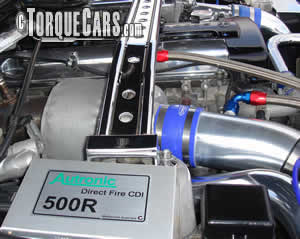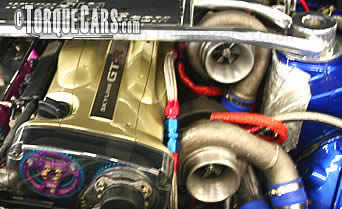Uprating the turbo with aftermarket turbos
"Gimme a boost"

When it comes to Turbo tuning you have pretty much unlimited potential and a wide selection of options.
The more power you want from a turbo the greater the amount of heat it will generate and the bigger the stress on the internal components.
A petrol engines turbo can reach temperatures up to 1100 degrees and speeds of 100,000 to 150,000 rpm with some modern small turbos reaching almost double that. A failed oil seal or worn bearing will be a kiss of death to a turbo and this is the biggest risk to a turbo at full throttle and high revs.
There are 2 main routes to upgrade your turbo. The first is relatively straightforward and can be carried out simply and easily by a reasonably competent mechanic. This is where an OEM (Original Equipment Manufacture) turbo is stripped down and reworked internally.
This is sometimes referred to an an aftermarket turbo although it still conforms to your standard turbo in terms of fitments and physical dimensions. You can get aftermarket turbo kits from a wide variety of retailers and turbo specialists.
Attention is given to the air intake aperture shape and turbine profile to maximise the flow of exhaust and air within the turbo housing.
Uprating the turbine fin shapes and geometry for maximum airflow and uprating the thrust bearings to ball bearings and fitting stronger seals will enable the turbo to tolerate much higher operating pressures and operate more freely. As the external parts of the turbo are the same as standard this becomes a swap in replacement.
Path 2 involves a more dramatic turbo design. All aspects of the turbo are rebuilt and often additional oil pipes and cooling pipes are included. Turbos are often cannibalised with the optimum parts from each formed into a hybrid unit.
Conversion to twin turbos and single large turbo replacements fall into this category although at the lower end of the spectrum many aftermarket turbo upgrade applications will only require a modified exhaust down pipe and perhaps due to taking up a little more space in the engine bay will require a few pipes and cables to be re-routed.
For best results the ECU (engine control unit) should be remapped so the characteristics of the turbo can be taken into account and maximum power can be extracted. More air in the engine will also require more fuel and depending on how much extra power you are wanting to extract you will also need to uprate the injectors and the fuel pump.
Although many of these uprated turbos are available off the shelf you are better off going to a specialist and detailing your desired requirements. Here are some of the options and goals you will need to think about. Generally you need to choose the power curve (do you want a large peak power figure on a narrow rpm band or are you looking for a wide torque band across the rev range. Are you after less lag and more instantaneous power - although this will be at the cost of a slightly lower peak power? Conversely a higher peak power will usually mean a larger amount of lag at lower revs.

A large turbo will tend to give a big amount of lag at low revs but provide a massive power hike at high revs. A twin turbo setup and good quality boost controller can minimise the amount of lag at low revs and give a good power gain throughout the rev range. It it also possible to have a small turbo and large turbo set up with a controller to use the small turbo at low revs and kick in the larger one as the revs increase.
Quad turbo installations are also being introduced by tuning houses along with standard OEM cars that run a supercharger and turbo simultaneously and various types of high-tech components such as ceramics, variable geometry turbines and ball bearings are being used in turbos. It is certainly an exciting time in the world of forced induction.
All types of turbo including diesel turbos can be upgraded in this way and 100% power gains are possible - but not always safe on standard internals. (As turbo diesel engines run less hot that petrol counterparts the turbos tend to be larger and therefore have more scope for modification as an OEM spec unit.) Diesel engine turbochargers run at lower exhaust gases so tend to be physically smaller than a petrol engine.
As with all modifications the higher the power gain the lower the reliability of the engine. When looking at increasing the engine power by over 70% you really should be thinking about uprating the internals of the engine and adding forged pistons etc...
Uprate the fuelling and may well need a custom boost controller and BOV. Whatever option you go for we strongly recommend an upgrade to a ball bearing based turbo unit as these spool up much faster, can tolerate higher speeds and hotter temperatures and are generally more reliable than the thrust bearing types of turbo.
If you want to learn more about turbo applications for your car please join our friendly car forums where you can chat with like minded car enthusiasts and talk technical.
Please Check out my YouTube channel, we're regularly adding new content...
PLEASE HELP: I NEED YOUR DONATIONS TO COVER THE COSTS OF RUNNING THIS SITE AND KEEP IT RUNNING. I do not charge you to access this website and it saves most TorqueCars readers $100's each year - but we are NON PROFIT and not even covering our costs. To keep us running PLEASE Donate here
If you liked this page please share it with your friends, drop a link to it in your favourite forum or use the bookmarking options to save it to your social media profile.
Feedback - What do You Think?
Please use our forums if you wish to ask a tuning question, and please note we do not sell parts or services, we are just an online magazine.
Help us improve, leave a suggestion or tip
Please watch this video and subscribe to my YouTube channel.

 Click to accept YouTube Cookies & Play.
Click to accept YouTube Cookies & Play.